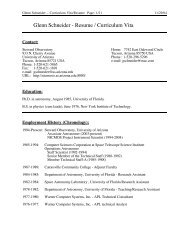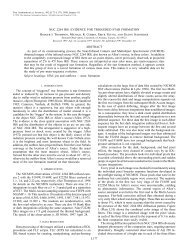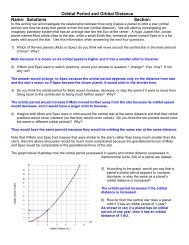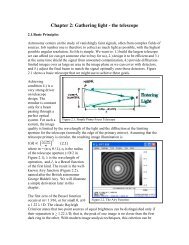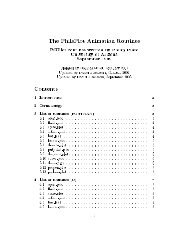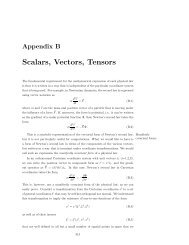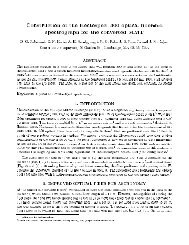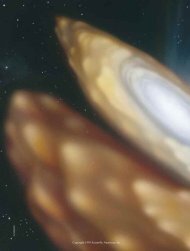ASTROPHYSICAL APL - DIAMONDS IN THE SKY
ASTROPHYSICAL APL - DIAMONDS IN THE SKY
ASTROPHYSICAL APL - DIAMONDS IN THE SKY
You also want an ePaper? Increase the reach of your titles
YUMPU automatically turns print PDFs into web optimized ePapers that Google loves.
In this paper we will outline the development of anastrophysical model using <strong>APL</strong>. To illustrate the flexibilityand lucidity of the notation, we attempted to identify thoseconditions which are often stated by <strong>APL</strong> opponents as beingadverse to the creation of an <strong>APL</strong> model, and then fmding anastrophysically interesting situation for which thoseconditions applied. In essence, we looked for things whichwe, and others, have conjectured that <strong>APL</strong> does not handlewell, and forced their incorporation into our model.Specifically, we demanded that the modeling of the physicalprocess under evaluation must be fundamentally iterative innature, forcing branching and re-execution of the linguisticalconstructs to be employed. Additionally, since <strong>APL</strong> naturallyhandles the manipulation of extensive multidimensionalarrays with ease (Metzger, 1981), in an adverse test the data tobe processed were to be of low rank (scalars, vectors, andmatrices) containing, in general, very small numbers ofelements. Since we were testing a numerical model, we feltthat the process should inherently have been computationallyextensive. Finally, for this illustrative example to bemeaningful to a broad spectrum of potential readers, we wishedto find a physical situation which was intrinsicallyinteresting, and not too narrowly channeled. To the latterpoint, the techniques used in the model would have to beroutinely used in diverse astronomical and physicaldisciplines.We felt that the classical problem of developing a stellarstructure model for white dwarf stars fit all of the abovecriteria. The numerical integrations of the structure equationsfrom the center of the star to the surface are inherently iterativeand computationally intensive. Yet, the physical situation isparametrized by only a few variables, and the number ofnumerical elements involved in each iteration step is small. Indeveloping the <strong>APL</strong> model, the method of approach to thesolution is as important as, and indeed is part of, the solutionitself. The actual “code” (a term we use hesitantly) isdeveloped in a bottom-up fashion, following the structuring ofthe physical principles employed in the model. There isnothing unique, ground breaking, or particularly inventive inthe implementation of the model which we present. Theunderlying physics is well understood. Indeed, this was anadditional requirement we imposed upon ourselves in selectinga situation to model for illustrative purposes.STRUCTURE MODELS - GENERAL CONCEPTSFor the purposes of developing a model of a stellar interior,the star may be thought of as being comprised of manyinfintesmally thin, spherically concentric shells. A structuremodel seeks to determine how the physical properties of thestar change at varying depths within the interior. Thisamounts to determining the “run of physical variables” fromthe center of the star to the surface (or vice-versa), througheach of the spherical shells. Some of the physical variableswhich are of interest include pressure and density at varyingdepths (i.e., within each shell), and the mass interior to eachshell.The process of solving the interior model involves expressingthe physical relationships between the structure variables asfunctions of the radial distance from the center of the star, andthen determining the numerical values of each of thosevariables throughout the interior. The form of the classicaldifferential equations of stellar structure, as described bySchwarzschild (1958), are discussed here as a background todeveloping the <strong>APL</strong> model which we will present.In the interior of a star two forces are in constant competition.The inward acting force of gravity, due to the star’s own mass,seeks to pull the outer layers of the star downward. Theinternal pressure of the gas, which comprises the stellarmaterial, acts to check this gravitational collapse. For thevast majority of a star’s life these two forces are in balance andthe star remains stable. This condition of hydrostaticequilibrium is expressed, for a region in the stellar interior, byequation [ 11.dPldr = -Gmrp ,/r* 111The pressure gradient (d Prldr ) across the regionspherical shell) in hydrostatic equilibriumdepends upon:(i.e.,r = the radial distance from the center of the starmr= the total mass interior to the regionpr= the density of the regionThe distribution of mass as a function of the radial distancefrom the center of the star is expressed by the equation of masscontirmity, written in differential form in equation [2]. As canbe seen, the differential equations of hydrostatic equilibriumand mass continuity both require a knowledge of the density ofthe region before they can be integrated.dmjdr = 4m-* p, VIThe gas pressure is related to the temperature and densitythrough an equation of state. The form of the equation of statedepends upon the underlying physics which governs thebehavior of the gas. The “perfect gas law”, which most of uslearned in high school chemistry, comes quite close to realityin physical situations of relatively low gas density, such as inthe Earth’s atmosphere and for most of the interior regions ofmain sequence stars. The perfect gas law assumes that thecollisional statistics between the particles in the gas arestrictly Maxwellian; all collisions are perfectly elastic, andboth external and inter-particle forces (such as Van der Wallsforces) are ignored (Sears, 1952). Under higher gas density, asoccur in the case of white dwarf stars, such simple assumptions’will not suffice.The third equation which describes the structure of the stellarinterior is the luminosity gradient equation, expressed in themost general form in equation [3]. This equation states thatthe radially directed luminosity gradient (i.e., the the netenergy loss), across the region is exactly compensated for bythe energy generated within the region. The energy generatedper unit mass, E, must include all energy sources. For mainsequence stars only nuclear energy sources are important,During the pre-main sequence phases of stellar evolution,when the star is undergoing gravitational contraction, boththermal and gravitational energy must also be considered.dLrldr = Edmjdr [31Equation [4], which has two forms, describes the radialtemperature gradient (d Tr/d r ) across a spherical shell in thestellar interior.<strong>APL</strong> QUOTE QUADSchneider, Paluui and Webb




